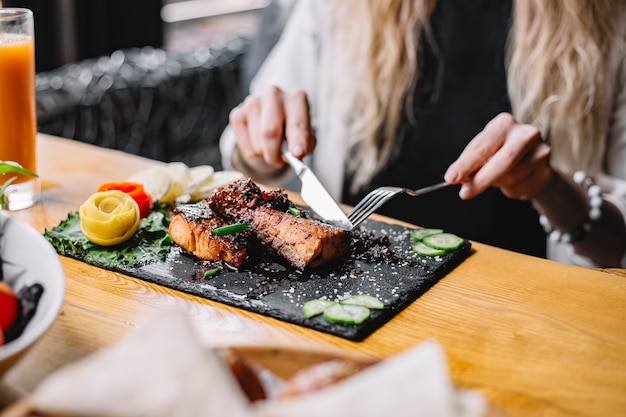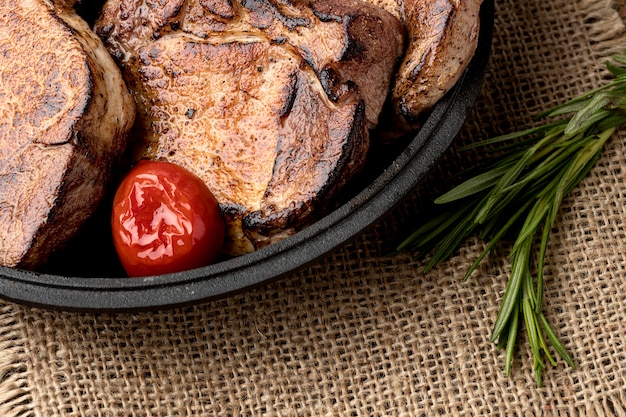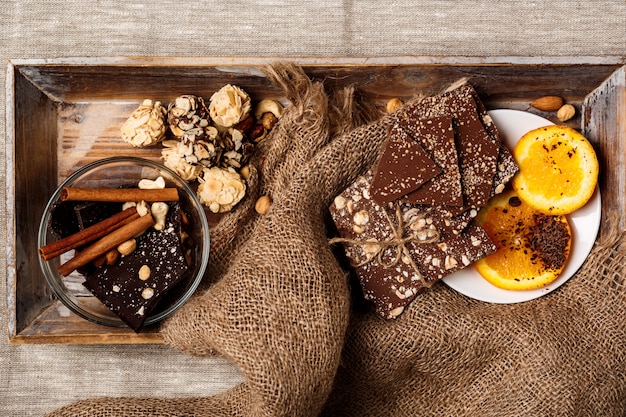The Rib Eye Roast: A Love Affair

Choosing the Perfect Cut: A Guide to Rib Eye Nirvana

Size Matters, My Friend
The size of your rib eye depends entirely on the size of your appetite, or more accurately, the size of your gathering. A small 2-bone rib eye roast is ideal for a romantic dinner for two or a cosy meal for four. For a larger group, a 3-4 bone roast can comfortably serve six to eight people.Marbling: The Key to Juicy Tenderness
Remember those beautiful streaks of white fat running through the meat? That's the magic of marbling, the secret ingredient that makes a rib eye melt-in-your-mouth tender. When you're at the butcher's, look for a rib eye that boasts a generous amount of marbling. The more marbling, the more flavourful and juicy your roast will be.Bone-In or Boneless? The Great Debate
This is a classic dilemma, and opinions vary. Personally, I'm a bone-in fanatic. The bone adds an extra layer of flavour to the roast, keeping it juicy and tender. Plus, there's something undeniably impressive about a bone-in rib eye, a touch of rustic charm that sets it apart.Preparing for Success: The Foundations of a Stellar Roast

The Art of Seasoning: A Symphony of Flavors
Seasoning is where you can really get creative and add your own personal touch. The classic approach is to simply use salt, pepper, and a good quality olive oil. But let's face it, life's too short for ordinary seasoning! I like to take my seasoning game to the next level. My personal favourite is a blend of smoked paprika, garlic powder, onion powder, and a pinch of cayenne for a subtle kick. But feel free to experiment and create your own signature blend. Try incorporating herbs like rosemary and thyme, a sprinkle of brown sugar for a hint of sweetness, or even a touch of citrus zest. The possibilities are endless!A Little Patience Goes a Long Way
Don't rush the process. Before you start cooking, allow the rib eye to come to room temperature. This will help it cook evenly and achieve that perfect, golden sear.Patting it Dry: A Crucial Detail
Patting the roast dry with paper towels before you begin cooking is a crucial step. It helps the skin get nice and crispy, adding another layer of texture to your masterpiece. It’s a small detail, but it makes a big difference.Mastering the Cooking Technique: Unlocking Rib Eye Perfection
Now, it's time to dive into the heart of the matter – the cooking process.The Roasting Method: A Symphony of Heat
Over the years, I've explored various cooking methods, but my ultimate favourite for rib eye roast is the reverse sear method. It's a technique that demands patience and precision, but the results are undeniably divine.Here's how it works:
- Start Low and Slow: Preheat your oven to 225°F. Place the seasoned roast on a rack in a roasting pan. This slow and steady approach allows the meat to cook evenly, tenderising it from the inside out. It's all about creating that melt-in-your-mouth texture that we crave.
- Patience is Key: Depending on the size of your roast, it will take about 2-3 hours for the internal temperature to reach 125°F. This is the point at which you want to remove it from the oven. We're aiming for medium-rare, so an internal temperature of 125°F is perfect.
- Rest and Revel: Once the roast comes out of the oven, let it rest for at least 30 minutes. This allows the juices to redistribute throughout the meat, resulting in a more succulent and flavorful roast.
- Time for the Sear: Preheat your cast iron pan over medium-high heat. Add a little bit of oil to the pan, then sear the roast for 1-2 minutes per side. This creates that beautiful, crispy crust that adds a satisfying crunch to each bite.
- Slice and Serve: Let the roast rest for another 10 minutes before slicing it and serving. This final resting period allows the juices to settle, ensuring every slice is juicy and tender.
Temperature is Key: The Science Behind a perfect roast
The key to a perfectly cooked rib eye roast is understanding the science behind internal temperature.The Magic of Internal Temperature
Using a meat thermometer is essential for achieving that perfect level of doneness. Here’s a handy guide to different levels of doneness and their corresponding internal temperatures:| Doneness | Internal Temperature (°F) | Description |
|---|---|---|
| Rare | 125-130°F | Red center, cool to the touch |
| Medium-Rare | 130-135°F | Slightly pink center, warm to the touch |
| Medium | 135-140°F | Pink center, warm to the touch |
| Medium-Well | 140-145°F | Barely pink center, hot to the touch |
| Well-Done | 145°F and above | No pink center, very hot to the touch |
The Finishing Touches: Elevate Your Culinary Masterpiece
Now, let's talk about the sides that will perfectly complement your rib eye roast.side dishes to Complement Your Culinary Creation
The possibilities for side dishes are endless!- Classics: Roasted vegetables, like asparagus, broccoli, or Brussels sprouts, are a timeless pairing for a rib eye roast. Their earthy flavours and crisp textures create a beautiful counterpoint to the richness of the meat.
- comfort food: mashed potatoes, creamy polenta, or cheesy macaroni and cheese are perfect for a comforting meal. They provide a soft and creamy counterpoint to the meat, creating a harmonious balance of textures and flavors.
- Global Inspiration: For a unique touch, try a side dish inspired by another culture. A couscous salad with dried fruit and nuts or a Mediterranean salad with olives, feta, and tomatoes can add a vibrant twist to your meal.
(Part 2)
The Art of Carving: Transforming Your Roast into Culinary Delights
Your rib eye has rested, it's time to carve it.Creating Slices of Perfection
This is a simple yet crucial step, one that can make or break your culinary masterpiece. You want to carve your rib eye into even, beautiful slices that showcase the magnificent marbling.Tools of the Trade
A sharp carving knife and a carving fork are your essential tools for this task. A sharp knife ensures clean, precise cuts, while the fork helps secure the meat while you slice.Slicing Techniques for Culinary Triumph
- Across the Grain: Slice across the grain of the meat, which are the thin lines running through the muscle fibres. Slicing against the grain can make the meat tough and chewy.
- Keep it Steady: Use a firm grip on your knife and slice with a smooth, steady motion. This ensures even, clean cuts that won't tear the meat.
- Don't Overcrowd: Don’t try to cut too many slices at once. This can make the meat tear, and it's best to take your time and enjoy the process.
- Leave the Bones In: For a rustic look, leave the bone in. It adds a touch of charm and makes the roast look even more impressive on the table. If you prefer a more traditional presentation, you can remove the bone before carving.
rib eye roast leftovers: Delicious Possibilities
Let's face it, leftover rib eye roast is a culinary blessing!Making the Most of Your Feast
There are countless ways to transform those delicious leftovers into new dishes.- Sandwiches: The next day, transform your leftover roast into delicious sandwiches on crusty bread with some horseradish sauce, your favourite cheese, and a few crunchy pickles. It's a perfect combination of flavours and textures that will satisfy your cravings.
- Salads: Dice up the leftovers and add them to your favourite salad for a protein-packed meal. The combination of the roast's rich flavour and the fresh vegetables will create a satisfying and nutritious lunch or dinner.
- Soup: Leftover rib eye is a great addition to hearty soups and stews. The meat will add a depth of flavour and richness to your favourite recipes.
- Pasta: Slice the leftover roast and toss it with your favourite pasta sauce and noodles for a quick and easy dinner. The flavour of the rib eye will complement the sauce beautifully, creating a truly satisfying meal.
FAQs
Here are some of the most common questions I receive about rib eye roast:
1. What’s the best way to store a rib eye roast?
To preserve the flavour and texture of your rib eye roast, keep it in the refrigerator wrapped tightly in plastic wrap or placed in an airtight container. If you’re planning to use it within a couple of days, it's fine to store it on a meat tray, but be sure to cover it with plastic wrap.
2. Can I freeze a rib eye roast?
Yes, you can freeze a rib eye roast, but it's best to do so before the roast has been thawed. To freeze, wrap the roast tightly in plastic wrap, then place it in a freezer bag, squeezing out as much air as possible. This will help prevent freezer burn and preserve the quality of the meat.
3. How long can I keep a rib eye roast in the freezer?
A frozen rib eye roast can be kept in the freezer for up to 6 months without compromising its quality. But for optimal flavour and tenderness, it's best to use it within 3-4 months.
4. Can I cook a rib eye roast from frozen?
It's not recommended to cook a rib eye roast from frozen. It will take longer to cook and might not achieve the same level of tenderness and juiciness. It's best to thaw it in the refrigerator for 1-2 days before cooking. This ensures the meat cooks evenly and reaches the desired level of doneness.
5. How long does it take to cook a rib eye roast?
The cooking time for a rib eye roast depends on its size and the desired level of doneness. A smaller roast will take less time than a larger one, and a well-done roast will take longer than a medium-rare roast. Using a meat thermometer will help you determine when the roast is cooked to your liking. For a medium-rare roast, using the reverse sear method, it typically takes around 2-3 hours in the oven, followed by a quick sear on the stovetop.
I hope this comprehensive guide has equipped you with the knowledge and confidence to cook a perfect rib eye roast that will impress your family and friends. Remember, it’s all about understanding the cut, mastering the techniques, and adding your own personal touch. So, go forth and create a culinary masterpiece that will leave everyone wanting more.
Everyone is watching

Prime Rib Roast Cooking Time Chart: Per Pound Guide
Cooking TipsPrime rib roast. Just the name conjures images of lavish dinners, crackling fires, and hearty laughter. It’s ...

How Long to Bake Potatoes in the Oven (Perfect Every Time)
Cooking TipsBaked potatoes are a staple in my kitchen. They're incredibly versatile, delicious, and surprisingly easy to m...

Perfect Rice Every Time: The Ultimate Guide to Cooking Rice
Cooking TipsAs a self-proclaimed foodie, I've always been a bit obsessed with rice. It's the foundation of countless cuisi...

The Ultimate Guide to Cooking Asparagus: Tips, Techniques, and Recipes
Cooking TipsAsparagus. The mere mention of this spring delicacy conjures up images of vibrant green spears, crisp and burs...

Ultimate Guide to Cooking the Perfect Thanksgiving Turkey
Cooking TipsThanksgiving. Just the word conjures up images of overflowing tables laden with delicious food, the scent of r...
